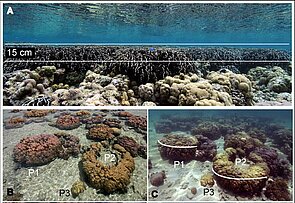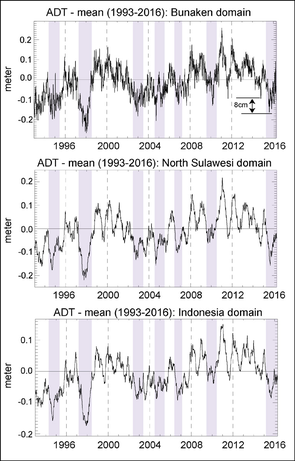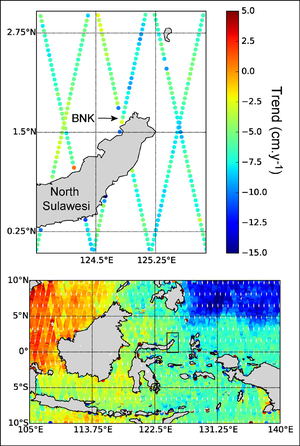How El Niño and related sea level fall impacted indonesian corals
Image of the Month - April 2017

Coral reefs play an important role in the marine and coastal ecosystems. Indonesia is at the core of the so-called "coral triangle", a vast area spanning Malaysia to Solomon Island, where the number of marine species is maximum.
One of the known El Niño effect on coral is the bleaching due to higher-than-usual water temperatures (the living part of the coral dies, leaving only the mineral (white) part of the coral, hence the bleaching).
However, variations in sea surface heights also occurs during an El Niño episode: increasing in the East Pacific, but decreasing in the West, close to Indonesia. Corals living just under the water surface can survive being uncovered (they usually are at low tide), but not for too long. When sea surface height is decreasing, the coral can be out of water longer than usual, thus leading to a higher coral mortality rate. An in situ survey led in 2016 showed a clear sharp horizontal limit of tissue mortality in some colonies.
Altimetry is measuring sea surface heights. Looking at the time series for the past 12 years (and more), September 2015 is the lowest sea surface height observed during those twelve years, lower of about 8 cm from the level in 2014. Using the higher resolution brought by Saral to get closer to the coasts corroborates the results obtained with gridded (open ocean) data. The same phenomenon probably occured in 1997-1998, but was not noticed at that time.
Altimetry, by providing with an important aspect of the physical environment of corals can help understanding their mortality. With more and more coastal-processed data, more local studies should be possible, waiting for Swot high-resolution coastal imagery.
See also:
- Applications: El Niño
- Data: Saral Geophysical Data Records
Websites on this subject:
References:
- Ampou, E. E., Johan, O., Menkes, C. E., Nino, F., Birol, F., Ouillon, S., and Andrefouet, S.: Coral mortality induced by the 2015–2016 El-Niño in Indonesia: the effect of rapid sea level fall, Biogeosciences Discuss., doi:10.5194/bg-2016-375, 2017.






